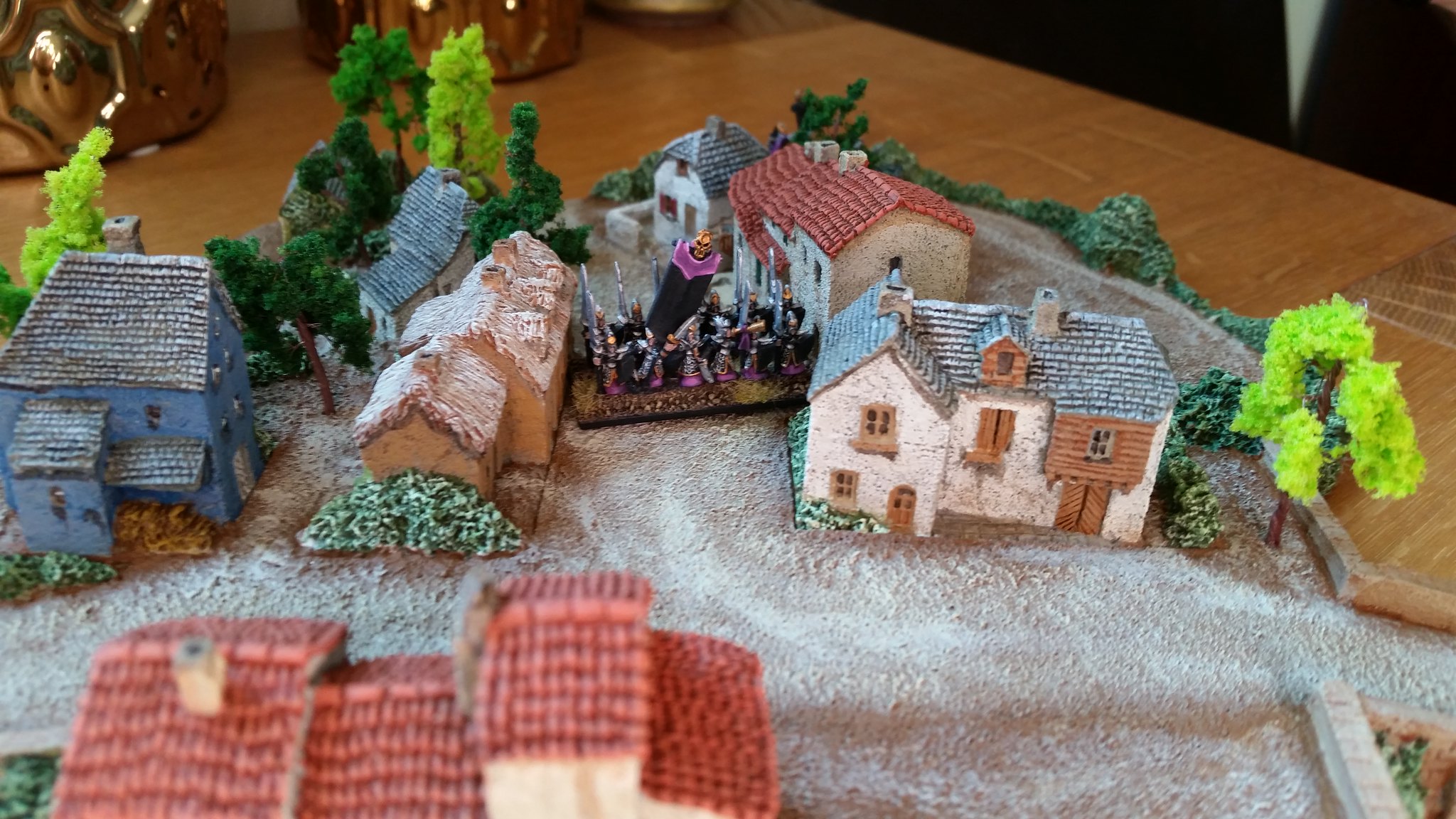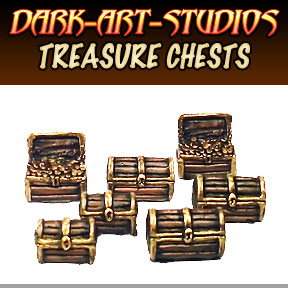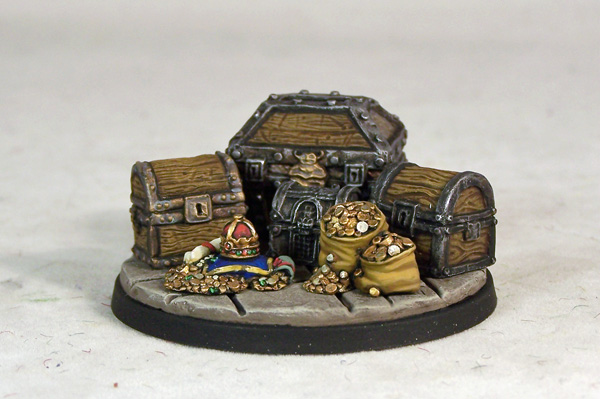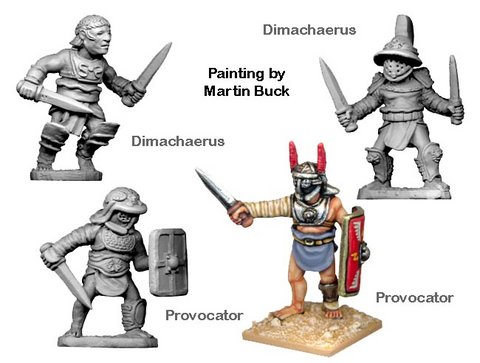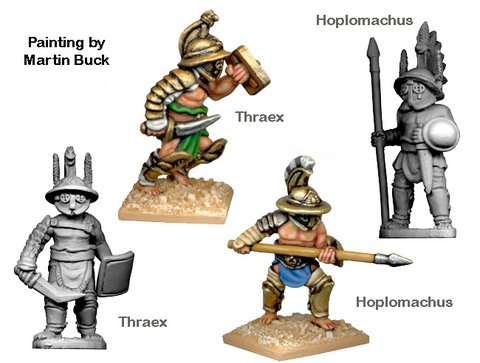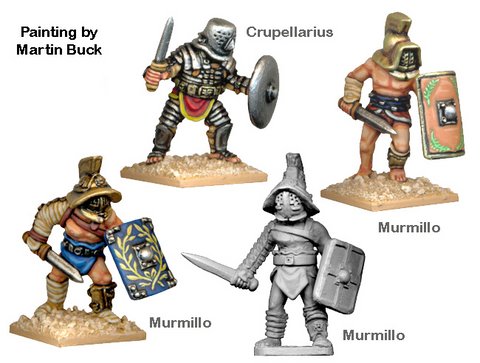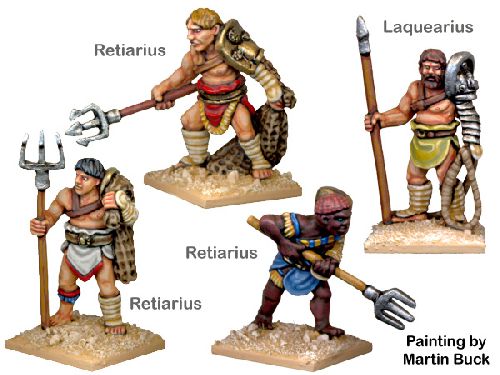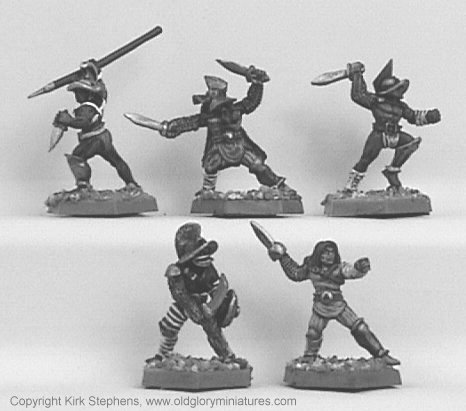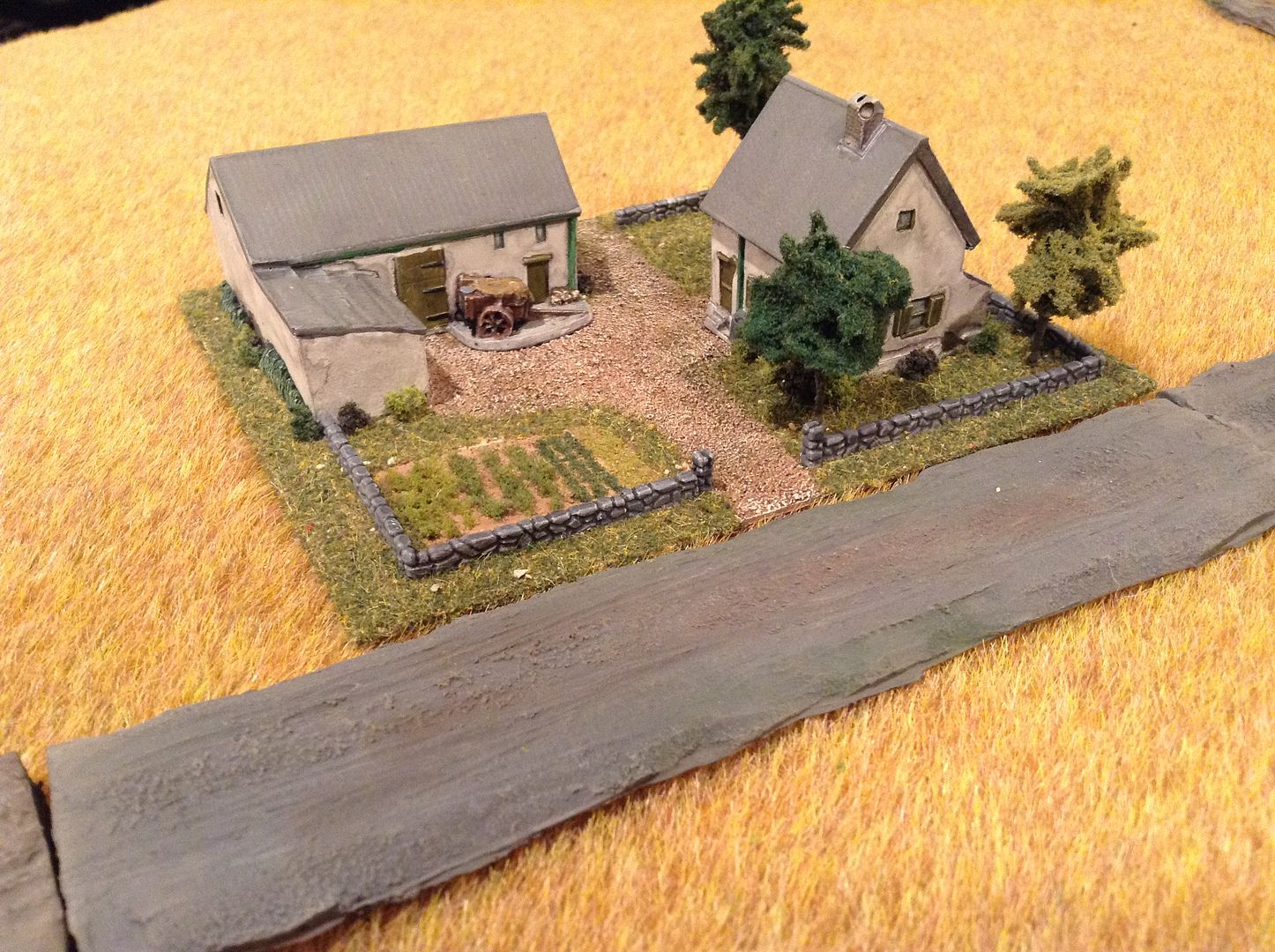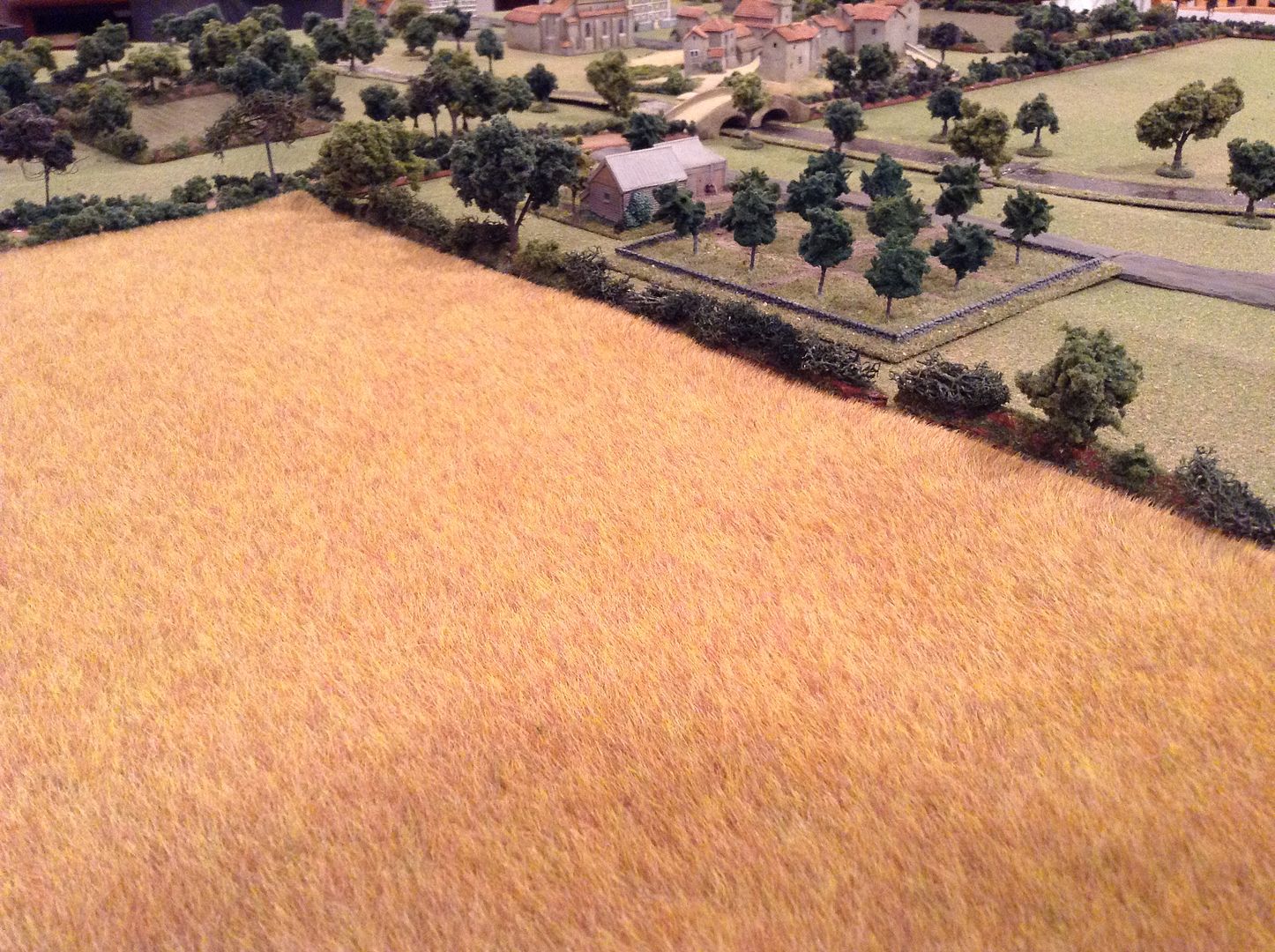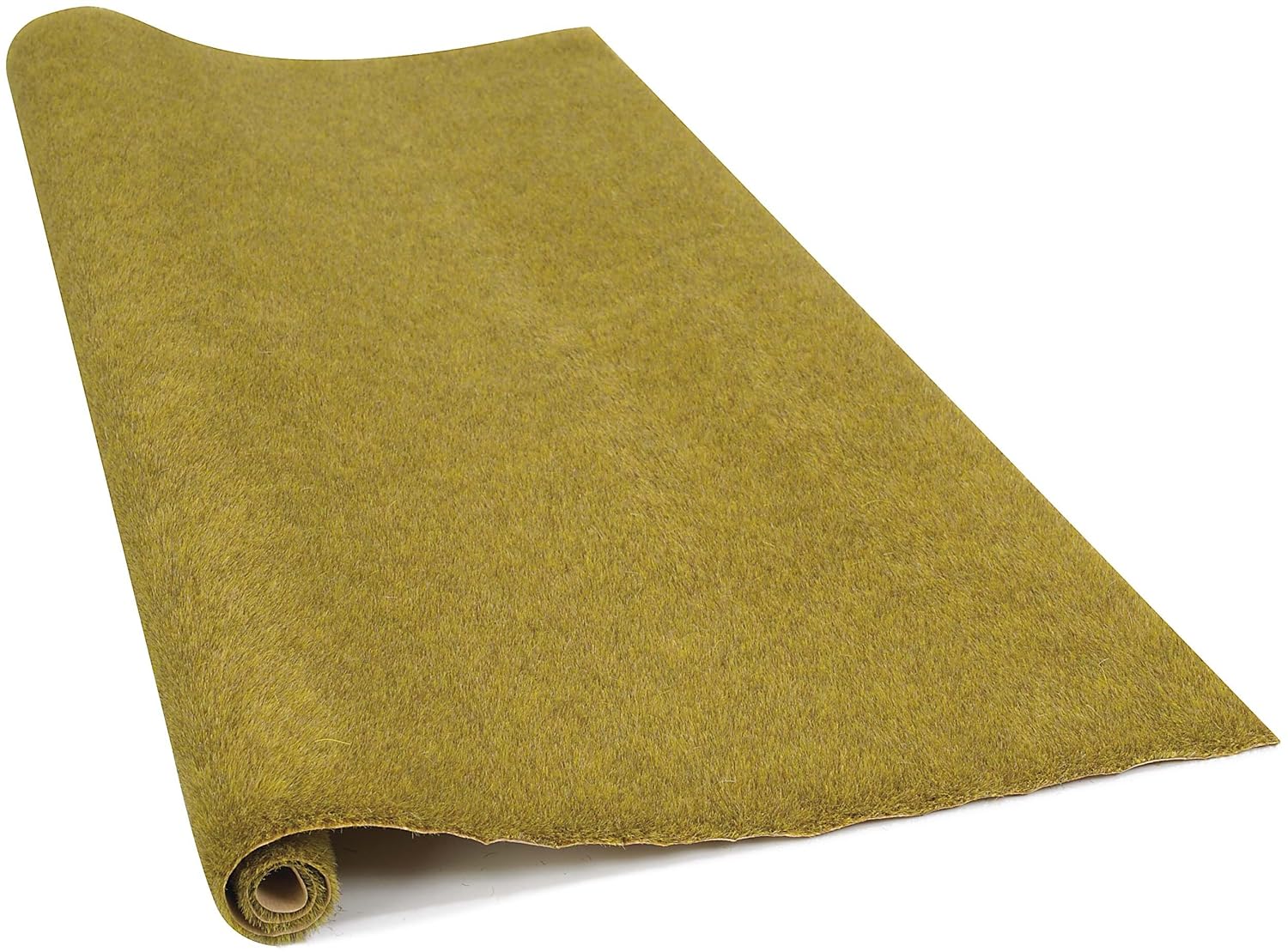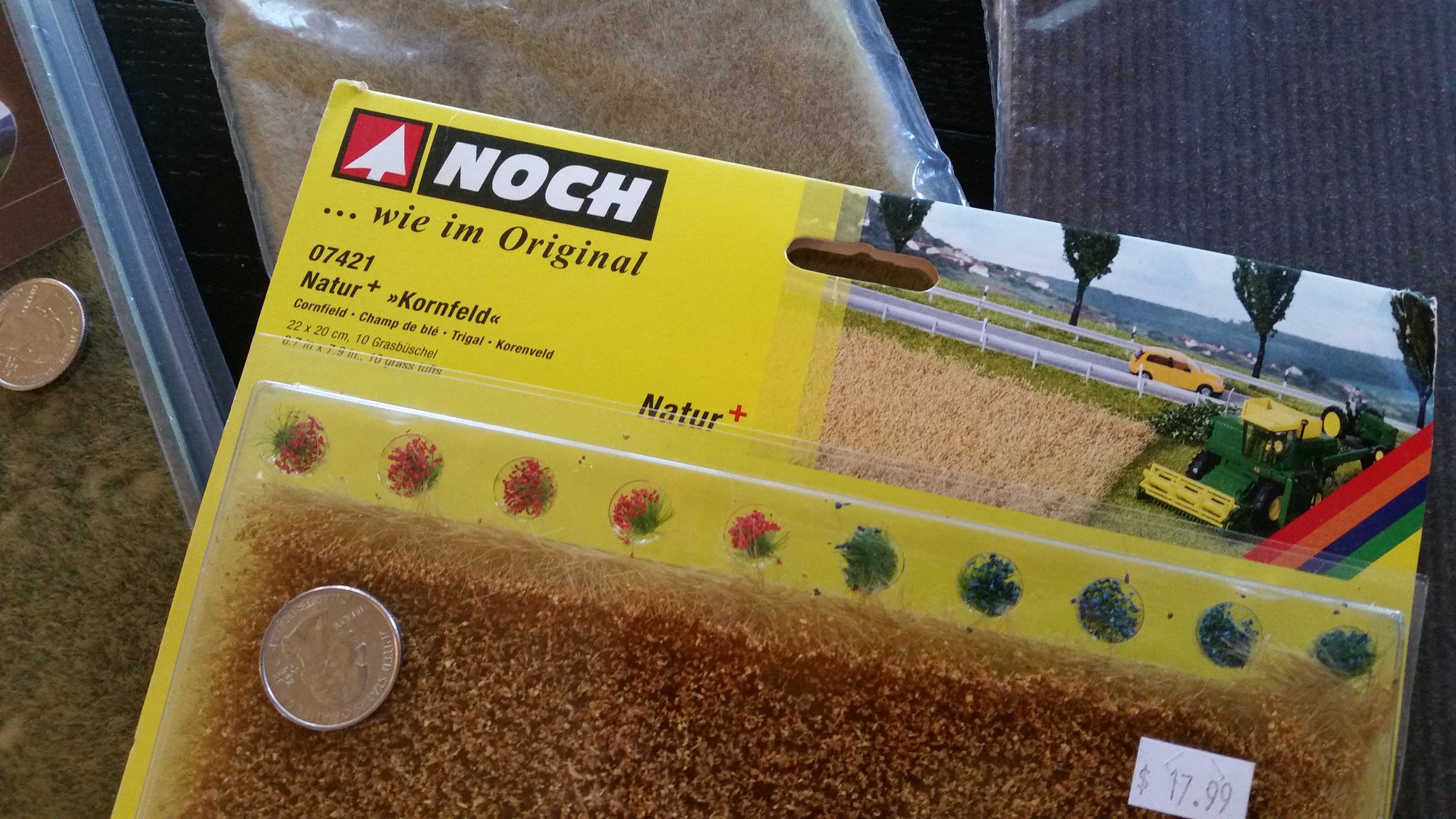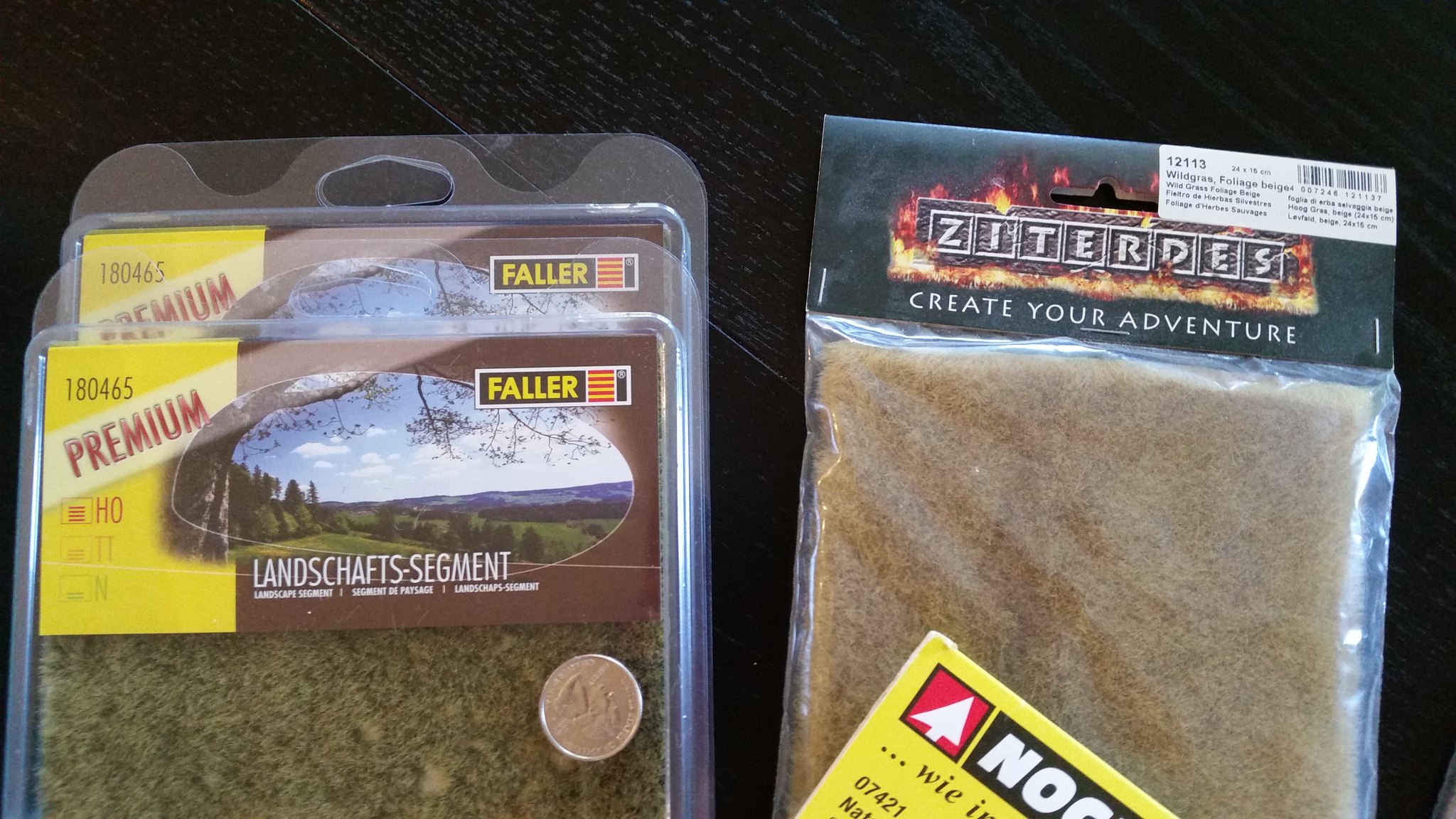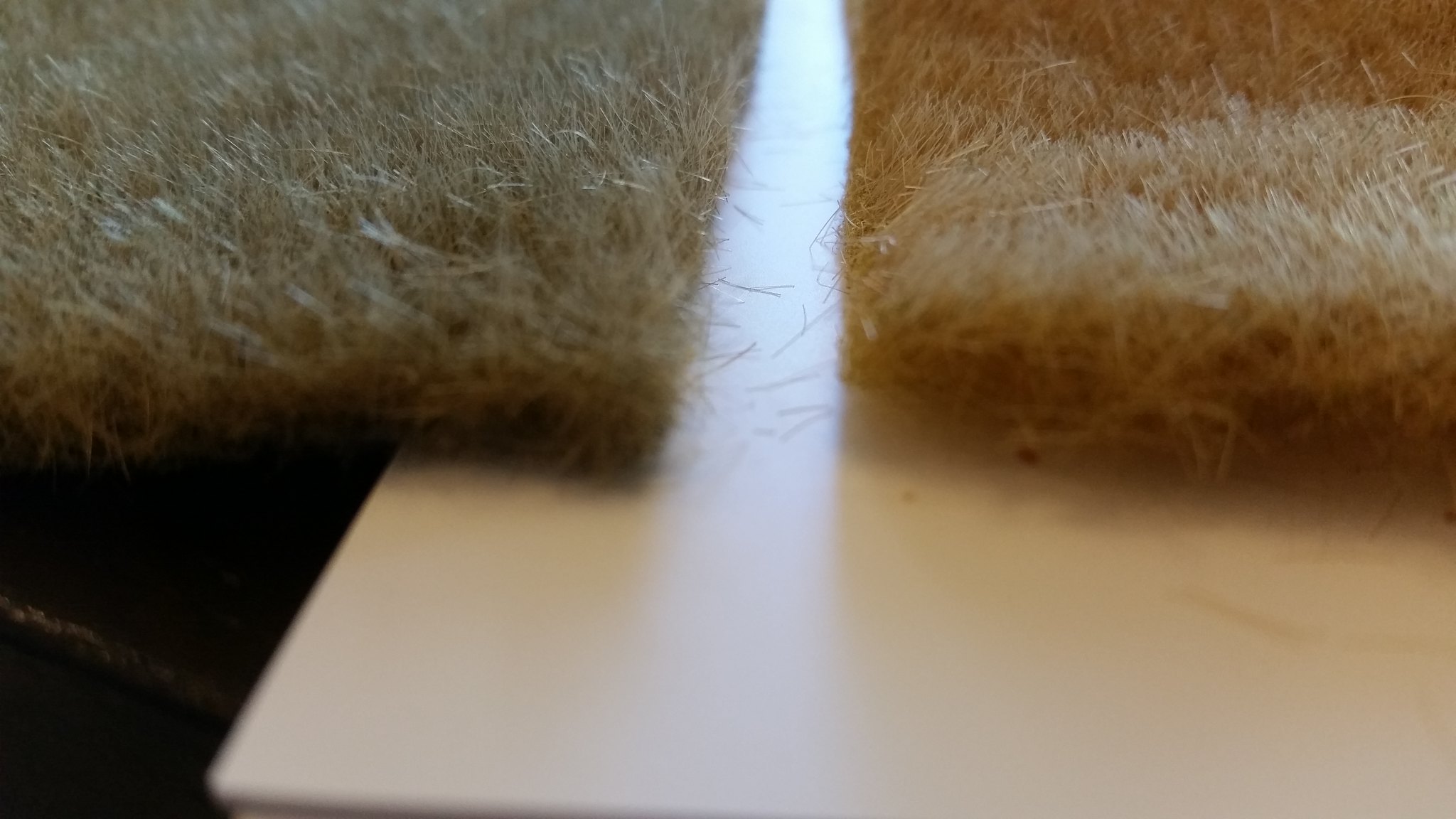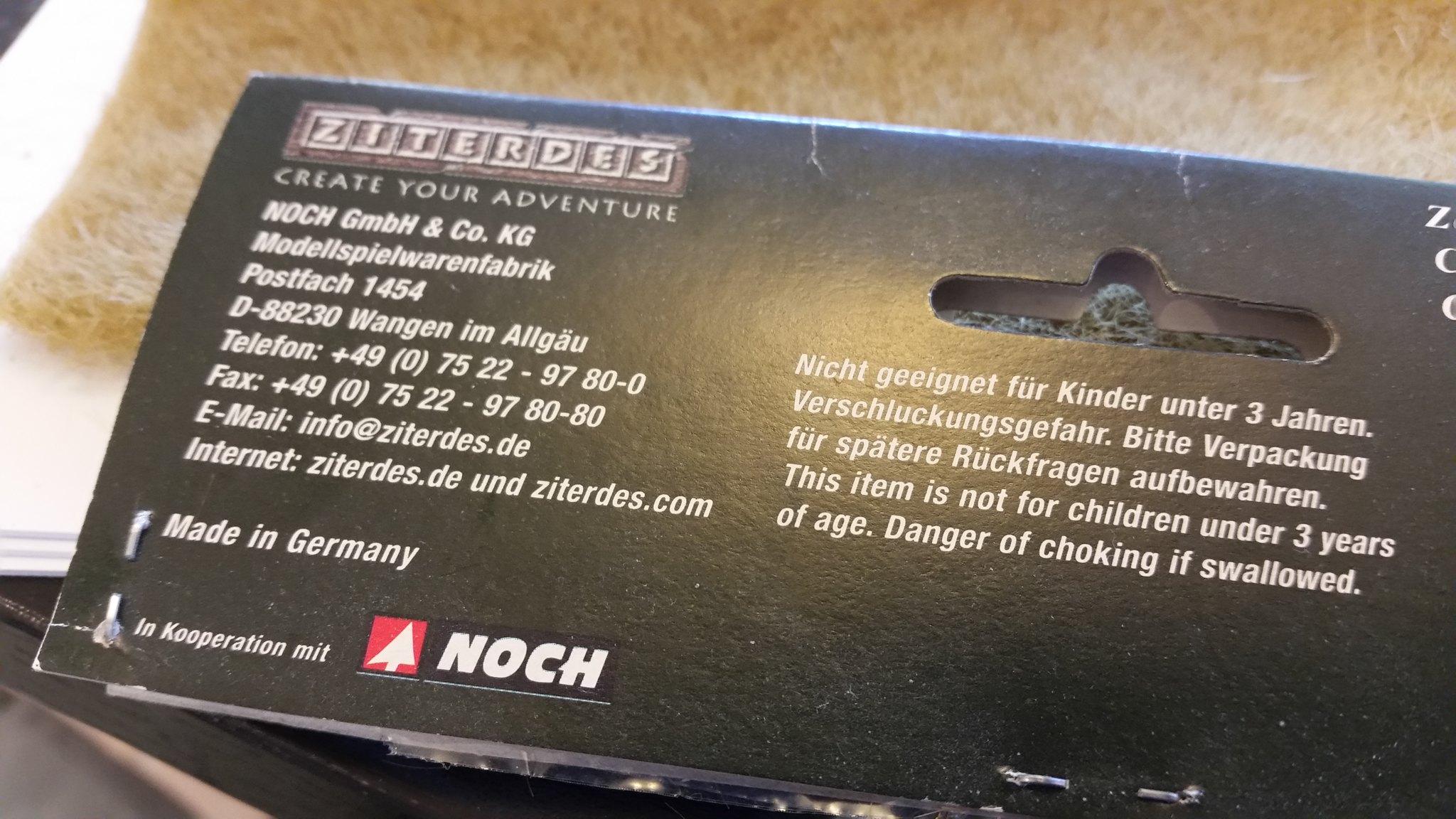Sometimes you've got the perfect color scheme for a model. Other times, you work your way through the paint bottles on your table until you've used them all...but SOMETIMES you have the primary color (or an idea for something), but aren't sure what accent to use.
Well, check this out:
http://www.thonky.com/random-hex-color/
Visit it, and it'll give you a color. Match it the best you can, and bam, Bob's your uncle!
About Me
- Kealios Achilles-Fang
- My name is Gavin McClements. I am a wargamer and family man, living in Los Gatos, which is a suburb of San Jose, CA. Building terrain is one of my favorite aspects of the wargaming hobby - in fact, lately I've become more interested in making my battlefields "pop" than in actually playing.
Tuesday, November 24, 2015
Monday, November 23, 2015
10mm or 6mm terrain for Warmaster?
I just wanted to repost this thread from the Specialist Forums, as it is near and dear to my heart:
Very simply:
"How do you go about with terrain for Warmaster?" He was asking about sizes and terrain templates/area terrain, basically.
My response:
"I play a lot of 6mm, and only Warmaster in 10mm. For me, it made no sense to buy 10mm terrain, so i continue to invest heavily in 6mm terrain."
But the response I wanted to preserve for eternity was that of Gorrin of London:
"Returning to the OP, and to give the two-cents'-worth of input from a (very) seasoned, middle-aged grand scale gamer (newbie to warmaster - but experienced in 2mm, 6mm and 10mm in other rulesets)...well here goes...
I would suggest for inspiration on some "diorama" type boards you google images search for grand scale terrain master "Bruce Weigle". His late 19th century boards are designed for the (small even for 6mm) Heriocs and Ros range but are a great reference for any scale up to 10-12mm. I believe he makes his buildings at around 60-70% of the scale of the figures to give the grand scale impression. I think that's about right. Scaling for 10mm I'd say that 6mm is about right, and that 10mm scenery is better suited to 15mm games. I agree with Kealios that owning a lot of 6mm and then investing in another bunch of scenery in a scale slightly larger (remember that most 6mm models are 6mm "foot to eye" and that most WM models - especially the infantry - are on the small side of 10mm) is fairly pointless. Total Battle Miniatures 6-7mm Pike and Shotte range is very "oldhammer" in style and the large range can be supplemented further with some of the Napoleonic range - the Napoleon in Russia range fulfilling much of my Kislevite needs.
When asked about the demise of Warhammer and "massed fantasy combat" (writing for his regular column in Wargames, Soldiers and Strategy magazine) Rick Priestley replied: "Massed combat? WFB is a 1:1 game with a skewed groundscale! 120 dwarfs versus 150 orcs isn't massed combat...it's a punch-up in a pub car-park!". I think that how we think about scenery in WM game is a throwback to 1:1 games (WFB is what I'd refer to as "large skirmish") where we are more comfortable with buildings being roughly the same scale as the models, if you want to think of your 30 WM orcs representing 30 orcs and 1 building representing one building in WM then do so by all means...but I don't understand why in those circumstances you wouldn't just play Warhammer with a bit of command and control thrown in.
By its very nature WM is a grand scale game representing massed combat with an emphasis on command and control and which largely plays down the differences in races emphasised in WFB. To play any game at grand scale requires you to immediately get your head around the abstraction of what the battlefield and the models represent. I think from Rick Priestley's original introduction to the game he specifically references that a 3-base regiment represents around six-hundred troops with a five frontage and 720 for those with six. Those of you with large armies, represent this for spectacle sake on your table. It will take twenty full regiments and sixty stands, two deep and thirty across to represent a single regiment in a four-deep line formation in 1:1 scale. They will take up a 1.2 metre frontage on your table. That is what your single 3-stand unit represents. Place a single 10mm scale cottage in front of them, how many of those 600 troops are shielded by that cottage? The regiment can no more claim a "cover" bonus or restricted LOS from that building than you could take shelter from a musket volley by hiding behind a tennis ball.
The truth is that in grand scale games, most of your scenery is just that...scenery - and therefore just there for show. It may sound counter-intuitive, but if you want to represent a farm-house and a barn on a grand scale battlefield - it should not really have any bearing on movement, shooting or LOS. A regiment would not be able to shelter behind nor would they be able to hide behind these buildings which compared to the footprint of the regiment would be absolutely tiny. Likewise the regiment should be able to move through the terrain feature without any penalty with the represented troops affected by the building - maybe around five percent of them - simply running to catch up with their comrades if they were slowed. Any set of buildings whose real-to-scale size could not be imagined to be able to fully obscure at least 200 troops (1 stand's worth) can be ignored. I take a stand in line formation to be in real scale terms to be 4 ranks deep so in dwarf terms that's 60 abreast (45 metres?), any obstruction that I don't think is big enough to cover this size of frontage I ignore as terrain feature.
What is important in grand scale games is agreeing what terrain features ARE important and agreeing on them battle to battle. In my experience the things you need to represent are:
Built up areas - an area containing more than two or three houses from a large hamlet, to villages, towns and parts of cities. The outskirts of the built up areas should be clearly delimited (say with brown cloth and buildings placed on them. The buildings themselves are individually irrelevant (unless specifically required to be relevant such as a temple etc) and the entire built up area should be treated as dense woods. Main roads can exist through the built up area if the players wish but units, must traverse them in column formation only (think I've see rules for these in WM somewhere - something like all sides of a column count as flanks and/or rear).
Woods and forest - as above, but with trees instead of buildings of course (!)
Specific areas of difficult ground - marshes, muddy ploughed fields (such as at Agincourt)
Specific defendable obstacles - walls, ridgelines, sunken roads, earthowrks etc. In these instances I am taking about specific and important defendable battlefield positions only. For example, the stone wall at Fredricksberg, the walls of Hougamont at Waterloo, the sunken road at Antietam, the Pratzen Heights at Austerlitz.
Everything else should have little if no effect, most hedges, gentle slopes (although these may not provide a defendable bonus they may obstruct LOS), thin treelines, small sections of wall, individual buildings or those deemed not to represent "built up areas" as defined above.
Sorry about the epic post! I've probably previously bored all concerned with my ACW terrain but I will try to take some pictures with WM figures to give you an idea - you'll just have to forgive the obviously ACW buildings as I don't have any WM 6mm buildings painted up!!
So for me...I prefer 6mm for 10mm games. Not least because I ignore most buildings the bigger they are the more they get in the way! And also...the 6mm range is massive compared to the 10mm ranges. Irregular miniatures even do a set of metal roofs, doors and windows with pegs you can just push into balsa to make your own. Of course scratch building buildings at this scale in very easy as well compared to 28mm.
2-cents worth...I've spewed out a fool's fortune!!"
Hope this was informative! I've posted these before, but some 10mm Dark Elves in my TBM 6mm village...
Very simply:
"How do you go about with terrain for Warmaster?" He was asking about sizes and terrain templates/area terrain, basically.
My response:
"I play a lot of 6mm, and only Warmaster in 10mm. For me, it made no sense to buy 10mm terrain, so i continue to invest heavily in 6mm terrain."
But the response I wanted to preserve for eternity was that of Gorrin of London:
"Returning to the OP, and to give the two-cents'-worth of input from a (very) seasoned, middle-aged grand scale gamer (newbie to warmaster - but experienced in 2mm, 6mm and 10mm in other rulesets)...well here goes...
I would suggest for inspiration on some "diorama" type boards you google images search for grand scale terrain master "Bruce Weigle". His late 19th century boards are designed for the (small even for 6mm) Heriocs and Ros range but are a great reference for any scale up to 10-12mm. I believe he makes his buildings at around 60-70% of the scale of the figures to give the grand scale impression. I think that's about right. Scaling for 10mm I'd say that 6mm is about right, and that 10mm scenery is better suited to 15mm games. I agree with Kealios that owning a lot of 6mm and then investing in another bunch of scenery in a scale slightly larger (remember that most 6mm models are 6mm "foot to eye" and that most WM models - especially the infantry - are on the small side of 10mm) is fairly pointless. Total Battle Miniatures 6-7mm Pike and Shotte range is very "oldhammer" in style and the large range can be supplemented further with some of the Napoleonic range - the Napoleon in Russia range fulfilling much of my Kislevite needs.
When asked about the demise of Warhammer and "massed fantasy combat" (writing for his regular column in Wargames, Soldiers and Strategy magazine) Rick Priestley replied: "Massed combat? WFB is a 1:1 game with a skewed groundscale! 120 dwarfs versus 150 orcs isn't massed combat...it's a punch-up in a pub car-park!". I think that how we think about scenery in WM game is a throwback to 1:1 games (WFB is what I'd refer to as "large skirmish") where we are more comfortable with buildings being roughly the same scale as the models, if you want to think of your 30 WM orcs representing 30 orcs and 1 building representing one building in WM then do so by all means...but I don't understand why in those circumstances you wouldn't just play Warhammer with a bit of command and control thrown in.
By its very nature WM is a grand scale game representing massed combat with an emphasis on command and control and which largely plays down the differences in races emphasised in WFB. To play any game at grand scale requires you to immediately get your head around the abstraction of what the battlefield and the models represent. I think from Rick Priestley's original introduction to the game he specifically references that a 3-base regiment represents around six-hundred troops with a five frontage and 720 for those with six. Those of you with large armies, represent this for spectacle sake on your table. It will take twenty full regiments and sixty stands, two deep and thirty across to represent a single regiment in a four-deep line formation in 1:1 scale. They will take up a 1.2 metre frontage on your table. That is what your single 3-stand unit represents. Place a single 10mm scale cottage in front of them, how many of those 600 troops are shielded by that cottage? The regiment can no more claim a "cover" bonus or restricted LOS from that building than you could take shelter from a musket volley by hiding behind a tennis ball.
The truth is that in grand scale games, most of your scenery is just that...scenery - and therefore just there for show. It may sound counter-intuitive, but if you want to represent a farm-house and a barn on a grand scale battlefield - it should not really have any bearing on movement, shooting or LOS. A regiment would not be able to shelter behind nor would they be able to hide behind these buildings which compared to the footprint of the regiment would be absolutely tiny. Likewise the regiment should be able to move through the terrain feature without any penalty with the represented troops affected by the building - maybe around five percent of them - simply running to catch up with their comrades if they were slowed. Any set of buildings whose real-to-scale size could not be imagined to be able to fully obscure at least 200 troops (1 stand's worth) can be ignored. I take a stand in line formation to be in real scale terms to be 4 ranks deep so in dwarf terms that's 60 abreast (45 metres?), any obstruction that I don't think is big enough to cover this size of frontage I ignore as terrain feature.
What is important in grand scale games is agreeing what terrain features ARE important and agreeing on them battle to battle. In my experience the things you need to represent are:
Built up areas - an area containing more than two or three houses from a large hamlet, to villages, towns and parts of cities. The outskirts of the built up areas should be clearly delimited (say with brown cloth and buildings placed on them. The buildings themselves are individually irrelevant (unless specifically required to be relevant such as a temple etc) and the entire built up area should be treated as dense woods. Main roads can exist through the built up area if the players wish but units, must traverse them in column formation only (think I've see rules for these in WM somewhere - something like all sides of a column count as flanks and/or rear).
Woods and forest - as above, but with trees instead of buildings of course (!)
Specific areas of difficult ground - marshes, muddy ploughed fields (such as at Agincourt)
Specific defendable obstacles - walls, ridgelines, sunken roads, earthowrks etc. In these instances I am taking about specific and important defendable battlefield positions only. For example, the stone wall at Fredricksberg, the walls of Hougamont at Waterloo, the sunken road at Antietam, the Pratzen Heights at Austerlitz.
Everything else should have little if no effect, most hedges, gentle slopes (although these may not provide a defendable bonus they may obstruct LOS), thin treelines, small sections of wall, individual buildings or those deemed not to represent "built up areas" as defined above.
Sorry about the epic post! I've probably previously bored all concerned with my ACW terrain but I will try to take some pictures with WM figures to give you an idea - you'll just have to forgive the obviously ACW buildings as I don't have any WM 6mm buildings painted up!!
So for me...I prefer 6mm for 10mm games. Not least because I ignore most buildings the bigger they are the more they get in the way! And also...the 6mm range is massive compared to the 10mm ranges. Irregular miniatures even do a set of metal roofs, doors and windows with pegs you can just push into balsa to make your own. Of course scratch building buildings at this scale in very easy as well compared to 28mm.
2-cents worth...I've spewed out a fool's fortune!!"
Hope this was informative! I've posted these before, but some 10mm Dark Elves in my TBM 6mm village...
Saturday, November 21, 2015
Leven Miniatures Blacksmith in 6mm
Awhile back, I placed a fairly large order with both Total Battle Miniatures and Leven Miniatures for 6mm buildings for my Warmaster set. I irdered some more stuff from Leven again...and inquired as to whether he had anything for a Blacksmith.
I could have sworn I wrote about this, but damned if I could find it. Anyway...he was working on an item, and ended up sending me the very first sample...I was so excited!
So I finally got it painted up.
I know - I HATE blurry pictures too, but I just have my phone. I tried making a glowing forge, so I started with reds and oranges, put black over, drybrushed a grey over for coals, and then used the yellow ink to make a glowing effect. Effective? I doubt it, but it's the effort that counts :)
Lastly, many of Leven's buildings have huge blank spots where openings are. I understand why, but just painting them black doesnt seem right to me. I tried a really limited "3D effect", using basic 3 point perspective.
Ideally, it's look like anything from here:
http://sciencevibe.com/2015/05/04/chalk-it-up-to-an-optical-illusion/
but you know...
I could have sworn I wrote about this, but damned if I could find it. Anyway...he was working on an item, and ended up sending me the very first sample...I was so excited!
So I finally got it painted up.
I know - I HATE blurry pictures too, but I just have my phone. I tried making a glowing forge, so I started with reds and oranges, put black over, drybrushed a grey over for coals, and then used the yellow ink to make a glowing effect. Effective? I doubt it, but it's the effort that counts :)
Ideally, it's look like anything from here:
http://sciencevibe.com/2015/05/04/chalk-it-up-to-an-optical-illusion/
but you know...
Frostgrave objective markers in the "Sparkly Pretty" style!
I haven't written in a while, but that doesn't mean I've been entirely void of output!
I've been playing a bit of Frostgrave lately, and this thread on Lead Adventure gave me a fun idea for my own objective markers.
I ran down to Michael's and picked up some essentials. My wife already had fine gold glitter.
Here you can see the finished results. I say "finished", but I realize that I haven't yet brushed them off, so some glitter appears to be on top of some of the items - it really isnt.
So..some easy stuff here, and i was pleased how they turned out.
By the way, for those of you who dont want to chase this stuff down here, the Dice Bag Lady has a really cool kit on her site:
http://thedicebaglady.net/real-treasure-gem-and-glitter-kit/
As for treasure and objectives I'd love to own, well...
Ristuls Market:
Zealot miniatures:
Dark Art Studios:
Otherworld Minis:
And who can forget Reaper!
Mantic:
Thomarillion:
Fenryll:
And for those of you who like to make your own:
http://abarothsworld.com/Tricks/treasures%20&%20trinkets.htm
I've been playing a bit of Frostgrave lately, and this thread on Lead Adventure gave me a fun idea for my own objective markers.
I ran down to Michael's and picked up some essentials. My wife already had fine gold glitter.
These "gems" came in so many colors, I couldnt help it. That, and they were on sale. You'll notice most are "Qty 120." One was 150, and one was 200. I wish the others were all on the "150" side, but they still work fine.
Here you can see the finished results. I say "finished", but I realize that I haven't yet brushed them off, so some glitter appears to be on top of some of the items - it really isnt.
By the way, for those of you who dont want to chase this stuff down here, the Dice Bag Lady has a really cool kit on her site:
http://thedicebaglady.net/real-treasure-gem-and-glitter-kit/
As for treasure and objectives I'd love to own, well...
Ristuls Market:
Zealot miniatures:
Dark Art Studios:
Otherworld Minis:
And who can forget Reaper!
Mantic:
Thomarillion:
Fenryll:
And for those of you who like to make your own:
http://abarothsworld.com/Tricks/treasures%20&%20trinkets.htm
Friday, October 9, 2015
Laserstorm for 6mm
I'm not going to do a long post here, but Laserstorm came out recently and looks really good. It has an Epic Armageddon-feel for the rules and a build-your-own mechanic that is along the lines of what I love.
http://twomarshals.blogspot.co.uk/p/laserstorm-calculator.html is an army builder for it, and I mostly wanted to get the link here for myself :)
http://twomarshals.blogspot.co.uk/p/laserstorm-calculator.html is an army builder for it, and I mostly wanted to get the link here for myself :)
Sunday, September 13, 2015
Roman Gladiators and Gladiatorial Games
A few weeks ago I was at a friends, and during one of our breaks, I wandered over to peruse his vast game shelves. I have done this countless other times, but this time I found a game that struck very near and dear to me:
I played Gladiator by Avalon Hill so much as a teenager! Seeing it on the shelf brought up the inevitable, and based on Aron's recommendation, I began watching Spartacus on Netflix. And yes, by the end of Season 2, I was looking up gladiatorial games. Who, me?
https://boardgamegeek.com/geeklist/43179/roman-gladiators was a list that got me started. Browsing the list over and over, I liked what I read, but without playing a game, how can you really ever be sure?
I started to develop some titles that I was leaning towards. I wanted something that allowed for variety between fighter types (before Spartacus, I hadnt really paid attention to the differences between Murmillo and Thraex, for example), focused primarily on 1v1 combat with a campaign system/opportunity to advance, and wasn't cumbersome (ie a little bit of how Gladiator was).
RULES
http://theminiaturespage.com/boards/msg.mv?id=146231 was another thread that really got me directed towards two rulesets in particular. After reading these two threads over and over, I have settled on these:
Arena Games - Freeform gladiator design, but it seems like it allows differences based on your actual model used.
Morituri Te Salutant with their Downloads section
Freebies:
Munera Sine Missione
Dragonrune: Arena of Death which is MSM but a Fantasy variant.
Of course, the Grandaddy of them all appears to be Blood on the Sands, still in development. I'll keep an eye on it as it progresses.
RESEARCH
With any learning comes research. This article got me going while I watched Spartacus, and I have:
http://www.amazon.com/gp/product/1846034728/ref=ox_sc_act_title_1?ie=UTF8&psc=1&smid=A2UNZ2TUS880YF and
http://www.amazon.com/gp/product/1841762997/ref=ox_sc_act_title_2?ie=UTF8&psc=1&smid=ATVPDKIKX0DER on their way.
MINIATURES
As far as miniatures go, yea, there are a ton in 28mm.
http://www.wargamesfoundry.com/ancients/gladiators/ seem to get the best press. My only uneducated problem with these superb sculpts are that some seem to not be "real" by what I've read. Murmillo should have rectangular shields from what I can tell, and Hoplomachus should have spears, not just short swords. (the original link to the BGG list confirms my suspicions). Bah, whatever, I'll buy a ton :) and YES, they look the best of all that I have seen.
These two are from this excellent thread and are from Foundry: http://www.lead-adventure.de/index.php?topic=61911.0
Crusader has an excellent line as well, though the look to be 28mm. They are reputed to be the most historically accurate, though they tend to be a bit beefy and not refined enough for my taste. I'll likely get some, but for a game that focuses on ONE model at a time, well, 28mm is rumored to be the "One True Scale" for detail. I just dont see that here.
Old Glory also has some minis... they actually look pretty nice and dynamic!
Michael Stockin at TWW pointed me towards these beauties by Moonraker.
Steve Barber has a KILLER arena and decent gladiators in 25mm (none that I plan on getting).
Brigade Games has some historical poses. I especially like their Thraex and Hoplomachus.
Black Hat, maker of Morituri Te Salutant, have their line up here. I am not impressed but something usable may come from this line.
So, now that I've got all that out of the way, I'll post my winners for the different Gladiator types here, and this shall begin my shopping list. Alphabetical list, with desriptions from the wiki:
Dimachaerus - The dimachaerus (Greek διμάχαιρος, "bearing two knives") used a sword in each hand. [I'd like a minimum of 2]
The unpainted Dimachaerus in the top right is nice. This is Crusaders ANG006
Hoplomachus - The Hoplomachus (Greek "armed fighter") wore quilted, trouser-like leg wrappings, loincloth, a belt, a pair of long shin-guards or greaves, an arm guard (manica) on the sword-arm, and a brimmed helmet that could be adorned with a plume of feathers on top and a single feather on each side. He was equipped with a gladius and a very small, round shield. He also carried a spear, which the gladiator would have to cast before closing for hand-to-hand combat. [I'd like a minimum of 2]
Crusader's ANG004 - the painted models look fantastic here, so I have to assume the non-painted models will paint up just as nicely.
This is the Brigade Games hoplomachus - I'm making a wild assumption that the purchased item comes with a spear!
Gauls - see Thraex, who "were introduced as replacements for the Gauls after Gaul made peace with Rome."
Gladiatrix - A female gladiator of any type. Also had to fight lions and bears by themselves. [I'll get one or two, most likely just for looks!]
Laquearius - The laquearius was a kind of retiarius who tried to catch his adversaries with a lasso (laqueus) instead of a net. He was equipped also with a dagger for use once he snared his opponent. [1, for originality's sake]
See the Foundry entry under Retiarius.
Murmillo - The murmillo (plural murmillones) or myrmillo wore a helmet with a stylised fish on the crest (the mormylos or sea fish), as well as an arm guard (manica), a loincloth and belt, a gaiter on his right leg, thick wrappings covering the tops of his feet, and a very short greave with an indentation for the padding at the top of the feet. They are heavily armoured gladiators: the murmillo carried a gladius (64–81 cm long) and a tall, oblong shield in the legionary style. [I'd like a minimum of 3]
These are nice sculpts from Crusader, "ANG001"
Provacator - In the late Republican and early Imperial era, the armament of a provocator ("challenger") mirrored legionary armature. In the later Imperial period, their armament ceased to reflect its military origins, and changes in armament followed changes in arena fashion only. Provocatores have been shown wearing a loincloth, a belt, a long greave on the left leg, a manica on the lower right arm, and a visored helmet without brim or crest, but with a feather on each side. They were the only gladiators protected by a breastplate (cardiophylax) which is usually rectangular, later often crescent-shaped. They fought with a tall, rectangular shield and the gladius. [minimum of 1]
See the Dimachaerus entry, above, for the Crusader model.
This is Brigade Games' offering. Nicely detailed.
Retiarius - The retiarius ("net fighter") developed in the early Augustan period. He carried a trident and a net. The retiarius wore a loincloth held in place by a wide belt and a larger arm guard (manica) extending to the shoulder and left side of the chest. He fought without the protection of a helmet. Occasionally a metal shoulder shield (galerus) was added to protect the neck and lower face. [Miminum of 2]
Foundry's "Prime Contenders - GLAD012" has both a nice Retiarius and a Laquearius - fortunately the Thracian/Thraex looks historical enough to use.
This is Crusader's ANG003. I really like the top dynamic pose.
Samnite - an older style, it seems: The Samnite was an early type of heavily armed fighter that disappeared in the early imperial period. A "Samnite" gladiator was armed with a long rectangular shield (scutum), a plumed helmet, a short sword, and probably a greave on his left leg.
Here, I like the far-right model with the blue shield. This is Foundry's "Saleh's Survivors - GLAD011"
Secutor - The secutor ("pursuer") developed to fight the retiarius. As a variant of the murmillo, he wore the same armour and weapons, including the tall rectangular shield and the gladius. The helmet of the secutor, however, covered the entire face with the exception of two small eye-holes in order to protect his face from the thin prongs of the trident of his opponent. The helmet was also round and smooth so that the retiarius net could not get a grip on it. [minimum of 2]
This is Foundry's "Copplestone's Conquerors - GLAD015" - see the model third from the right, with the purple-trimmed shield.
Brigade Games' offering, which is a little creepy looking, but does the trick.
Thraex - The Thraex (plural Thraeces, "Thracians") wore the same protective armour as the hoplomachi with a broad rimmed helmet that enclosed the entire head, distinguished by a stylized griffin on the protome or front of the crest (the griffin was the companion of the avenging goddess Nemesis), a small round or square-shaped shield (parmula), and two thigh-length greaves. His weapon was the Thracian curved sword (sica or falx, c. 34 cm or 13 in long).
Here, I like the 3rd model from the left, with the green accent. Foundry's "Prime Contenders - GLAD012"
This is Foundry's "Copplestone's Conquerors - GLAD015" - see the far right model.
See also the Hoplomachus entry, above, for the Crusader options.
Other buys:
Old Glory's ZGW-02 "Medium Gladiators"
Final Buy Guide:
Foundry - GLAD011, GLAD012, GLAD015, GLAD023, GLAD025
Crusader - ANG001, ANG003, ANG004, ANG006
Old Glory - ZGW-02 "Medium Gladiators"
Brigade Games - BG-GLA001B "Provocator", BG-GLA001A "Secutor", BG-GLA001E "Hoplomachus"
Buying this way will cost a lot of money, with quite a few "left overs", but it will let me field what I want and use the others as needed.
EDIT: this guy has a fantastic Gladiator-inspired blog:
http://zabadakgladiator.blogspot.com/2015/06/rules.html
I played Gladiator by Avalon Hill so much as a teenager! Seeing it on the shelf brought up the inevitable, and based on Aron's recommendation, I began watching Spartacus on Netflix. And yes, by the end of Season 2, I was looking up gladiatorial games. Who, me?
https://boardgamegeek.com/geeklist/43179/roman-gladiators was a list that got me started. Browsing the list over and over, I liked what I read, but without playing a game, how can you really ever be sure?
I started to develop some titles that I was leaning towards. I wanted something that allowed for variety between fighter types (before Spartacus, I hadnt really paid attention to the differences between Murmillo and Thraex, for example), focused primarily on 1v1 combat with a campaign system/opportunity to advance, and wasn't cumbersome (ie a little bit of how Gladiator was).
RULES
http://theminiaturespage.com/boards/msg.mv?id=146231 was another thread that really got me directed towards two rulesets in particular. After reading these two threads over and over, I have settled on these:
Arena Games - Freeform gladiator design, but it seems like it allows differences based on your actual model used.
Morituri Te Salutant with their Downloads section
Freebies:
Munera Sine Missione
Dragonrune: Arena of Death which is MSM but a Fantasy variant.
Of course, the Grandaddy of them all appears to be Blood on the Sands, still in development. I'll keep an eye on it as it progresses.
RESEARCH
With any learning comes research. This article got me going while I watched Spartacus, and I have:
http://www.amazon.com/gp/product/1846034728/ref=ox_sc_act_title_1?ie=UTF8&psc=1&smid=A2UNZ2TUS880YF and
http://www.amazon.com/gp/product/1841762997/ref=ox_sc_act_title_2?ie=UTF8&psc=1&smid=ATVPDKIKX0DER on their way.
MINIATURES
As far as miniatures go, yea, there are a ton in 28mm.
http://www.wargamesfoundry.com/ancients/gladiators/ seem to get the best press. My only uneducated problem with these superb sculpts are that some seem to not be "real" by what I've read. Murmillo should have rectangular shields from what I can tell, and Hoplomachus should have spears, not just short swords. (the original link to the BGG list confirms my suspicions). Bah, whatever, I'll buy a ton :) and YES, they look the best of all that I have seen.
These two are from this excellent thread and are from Foundry: http://www.lead-adventure.de/index.php?topic=61911.0
Crusader has an excellent line as well, though the look to be 28mm. They are reputed to be the most historically accurate, though they tend to be a bit beefy and not refined enough for my taste. I'll likely get some, but for a game that focuses on ONE model at a time, well, 28mm is rumored to be the "One True Scale" for detail. I just dont see that here.
Old Glory also has some minis... they actually look pretty nice and dynamic!
Michael Stockin at TWW pointed me towards these beauties by Moonraker.
Steve Barber has a KILLER arena and decent gladiators in 25mm (none that I plan on getting).
Brigade Games has some historical poses. I especially like their Thraex and Hoplomachus.
Black Hat, maker of Morituri Te Salutant, have their line up here. I am not impressed but something usable may come from this line.
So, now that I've got all that out of the way, I'll post my winners for the different Gladiator types here, and this shall begin my shopping list. Alphabetical list, with desriptions from the wiki:
Dimachaerus - The dimachaerus (Greek διμάχαιρος, "bearing two knives") used a sword in each hand. [I'd like a minimum of 2]
The unpainted Dimachaerus in the top right is nice. This is Crusaders ANG006
Hoplomachus - The Hoplomachus (Greek "armed fighter") wore quilted, trouser-like leg wrappings, loincloth, a belt, a pair of long shin-guards or greaves, an arm guard (manica) on the sword-arm, and a brimmed helmet that could be adorned with a plume of feathers on top and a single feather on each side. He was equipped with a gladius and a very small, round shield. He also carried a spear, which the gladiator would have to cast before closing for hand-to-hand combat. [I'd like a minimum of 2]
Crusader's ANG004 - the painted models look fantastic here, so I have to assume the non-painted models will paint up just as nicely.
This is the Brigade Games hoplomachus - I'm making a wild assumption that the purchased item comes with a spear!
Gauls - see Thraex, who "were introduced as replacements for the Gauls after Gaul made peace with Rome."
Gladiatrix - A female gladiator of any type. Also had to fight lions and bears by themselves. [I'll get one or two, most likely just for looks!]
Laquearius - The laquearius was a kind of retiarius who tried to catch his adversaries with a lasso (laqueus) instead of a net. He was equipped also with a dagger for use once he snared his opponent. [1, for originality's sake]
See the Foundry entry under Retiarius.
Murmillo - The murmillo (plural murmillones) or myrmillo wore a helmet with a stylised fish on the crest (the mormylos or sea fish), as well as an arm guard (manica), a loincloth and belt, a gaiter on his right leg, thick wrappings covering the tops of his feet, and a very short greave with an indentation for the padding at the top of the feet. They are heavily armoured gladiators: the murmillo carried a gladius (64–81 cm long) and a tall, oblong shield in the legionary style. [I'd like a minimum of 3]
These are nice sculpts from Crusader, "ANG001"
Provacator - In the late Republican and early Imperial era, the armament of a provocator ("challenger") mirrored legionary armature. In the later Imperial period, their armament ceased to reflect its military origins, and changes in armament followed changes in arena fashion only. Provocatores have been shown wearing a loincloth, a belt, a long greave on the left leg, a manica on the lower right arm, and a visored helmet without brim or crest, but with a feather on each side. They were the only gladiators protected by a breastplate (cardiophylax) which is usually rectangular, later often crescent-shaped. They fought with a tall, rectangular shield and the gladius. [minimum of 1]
See the Dimachaerus entry, above, for the Crusader model.
This is Brigade Games' offering. Nicely detailed.
Retiarius - The retiarius ("net fighter") developed in the early Augustan period. He carried a trident and a net. The retiarius wore a loincloth held in place by a wide belt and a larger arm guard (manica) extending to the shoulder and left side of the chest. He fought without the protection of a helmet. Occasionally a metal shoulder shield (galerus) was added to protect the neck and lower face. [Miminum of 2]
Foundry's "Prime Contenders - GLAD012" has both a nice Retiarius and a Laquearius - fortunately the Thracian/Thraex looks historical enough to use.
This is Crusader's ANG003. I really like the top dynamic pose.
Samnite - an older style, it seems: The Samnite was an early type of heavily armed fighter that disappeared in the early imperial period. A "Samnite" gladiator was armed with a long rectangular shield (scutum), a plumed helmet, a short sword, and probably a greave on his left leg.
Here, I like the far-right model with the blue shield. This is Foundry's "Saleh's Survivors - GLAD011"
Secutor - The secutor ("pursuer") developed to fight the retiarius. As a variant of the murmillo, he wore the same armour and weapons, including the tall rectangular shield and the gladius. The helmet of the secutor, however, covered the entire face with the exception of two small eye-holes in order to protect his face from the thin prongs of the trident of his opponent. The helmet was also round and smooth so that the retiarius net could not get a grip on it. [minimum of 2]
This is Foundry's "Copplestone's Conquerors - GLAD015" - see the model third from the right, with the purple-trimmed shield.
Brigade Games' offering, which is a little creepy looking, but does the trick.
Thraex - The Thraex (plural Thraeces, "Thracians") wore the same protective armour as the hoplomachi with a broad rimmed helmet that enclosed the entire head, distinguished by a stylized griffin on the protome or front of the crest (the griffin was the companion of the avenging goddess Nemesis), a small round or square-shaped shield (parmula), and two thigh-length greaves. His weapon was the Thracian curved sword (sica or falx, c. 34 cm or 13 in long).
Here, I like the 3rd model from the left, with the green accent. Foundry's "Prime Contenders - GLAD012"
This is Foundry's "Copplestone's Conquerors - GLAD015" - see the far right model.
See also the Hoplomachus entry, above, for the Crusader options.
Other buys:
Old Glory's ZGW-02 "Medium Gladiators"
Final Buy Guide:
Foundry - GLAD011, GLAD012, GLAD015, GLAD023, GLAD025
Crusader - ANG001, ANG003, ANG004, ANG006
Old Glory - ZGW-02 "Medium Gladiators"
Brigade Games - BG-GLA001B "Provocator", BG-GLA001A "Secutor", BG-GLA001E "Hoplomachus"
Buying this way will cost a lot of money, with quite a few "left overs", but it will let me field what I want and use the others as needed.
EDIT: this guy has a fantastic Gladiator-inspired blog:
http://zabadakgladiator.blogspot.com/2015/06/rules.html
Thursday, August 13, 2015
How Warmaster compares to Hail Caesar - for 10mm
I love rulesets, like most gamers. I love rulesets more than most, I suspect, because I love to read and edit - it's just what I do. But mostly, I love to see how different people introduce similar concepts (really, how many ways are there to describe how to measure range, for example?).
I also like shiny things, and next-gen rulesets are often that. Unless your company has the initials "GW" in it, it is usually assumed that the latest edition of a set of rules improves upon its predecessors - not always, but usually. I believe this is the case with Warmaster, Warmaster Ancients, and now Hail Caesar.
There are quite a few reviews out there for Hail Caesar. Among them, I found:
https://meeples.wordpress.com/reviews/rules-reviews/ancients/hail-caesar-review/
http://toomuchlead.blogspot.com/2011/09/hail-caesar-full-review.html
http://campcromwell.blogspot.com/2011/05/hail-caesar-review.html
The thread I started on the Specialist Arms forum is a good one, too, I think:
http://www.forum.specialist-arms.com/index.php?topic=7300.0
First, let me link this here - the whole reason I bought Hail Caesar was because I caught wind of Ady's Fantasy mod for HC. I have since joined the Hail Caesar Fantasy Yahoo group, but Ady's work will be my foundation, I believe.
I want to make some of my own detailed notes about the differences and similarities between Warmaster and Hail Caesar, mostly because I am really interested in playing HC (up til now, I've only been reading and digesting the book over and over).
Hail Caesar has been called "Warmaster with less dice". Other differences as noted on https://boardgamegeek.com/thread/659828/difference-between-hail-caesar-and-warmaster-ancie:
Each unit is given one order, how well you succeed determines how many moves the unit can make.
A unit doesn't loose stands, only reduces in effectiveness.
You roll far less dice in a HC combat.
1. In WMA, most units consist of three stands. Units in HC come in varying sizes: standard, large, small, and tiny. Unit frontage is a key factor, and most units are at least two ranks deep. While there are different unit sizes - only small and regular make much sense in game. Tiny are really only for scenario specific stuff, and large seem to get very little benefit for their increase in footprint. Frontage is what matters, depth is not really very important.
2. There is a wider range of troop types available in HC. There is also a much greater variety of possible unit formations. Not sure there are really that much difference in number of troop types. Also while HC has several prescribed formations - in WM you can arrange your formation as you wish.
3. In WMA, each unit may be given up to three commands per turn, with each command and die roll being made in succession. In HC, the unit's orders must be stated out loud, then a die roll determines whether the unit can make zero, one, two, or three moves to complete its orders. Move distances are also a bit smaller in HC. Move distances are smaller in HC? Light Cavalry can move huge distances in HC
4. In WMA, each unit has a single Attack value. In HC, each unit has two separate values for ranged combat (Short and Long), and two separate values for hand-to-hand combat (initial Clash and Sustained fighting). Clash / Sustained is only different for Cavalry - and this is good - it makes cavalry good on the charge, less good after round 1.
5. There is no Armour Save in HC, although the Morale Save serves a similar function. In HC, each unit also has a Stamina value - if a unit takes more hits than this value, it becomes Shaken and suffers various penalties. Under certain circumstances, units being attacked in ranged or hand-to-hand combat also must take a Break test to see if they hold, give ground, or break and run away. Armour Save / Morale save - same thing, different name. The Break test in HC is key - this is a 2d6 result that determines the result of a combat. This can make or break the game for you. Its possible for a very good unit to rout off the table after getting 1 wound from missile fire. We house ruled that you rolled 3d6 for break tests, and kept the best 2 dice. This helped stop some of the crazy fluctuations in results.
6. HC also includes a number of useful optional rules to add historical characteristics and flavor to various units. Yes HC lists all the optional rules together - but WM just lists them with each army list - no real difference here.
7. In WMA, armies tend to be built to standard point values. HC is much more oriented toward scenario play, with little emphasis on points-based armies. The HC rulebook includes seven complete sample scenarios. Points - while the core HC book had very little in the way of points, there have been several army books since that are much more points focused.
Things that seemed a bigger difference to me would include:
More streamlined combat - no more endless rounds of WM combat.
Simpler combat - no fiddling around with single stand removal, fall backs and follow-ups.
HC has longer combats between heavy infantry - these turn into long slugging matches not a knock out punch
HC Knights are much less strong than in WM (which is good)
Skirmishers work well in HC
HC proximity rule works fairly well to limit movement when close to enemy, but can be a bit fiddly, and can be exploited.
Movement in HC is still pretty free an easy (like WM)
Light Infantry is very good
The above was cut-and-paste from the thread I started, and it was what I focused on the most during my explorations. I have to say, however, that there are a few other things that seem to really make a difference to me as I read the HC rules.
Divisions (formerly called brigades) - these are assigned before the game. A commander must be included in a division, and can only give orders to that division. The neat thing is, units must be within 6" of each other to receive a Division order - so they dont need to be touching.
Basing - I plan on using my Warmaster armies for HC, and I plan on using them as-is - so my infantry will be 3 bases of 40m x 20mm, cavalry will be 3 stands based to the short edge, etc. If this proves unwieldy or unfair, I'll revisit it, but that is my plan for now. Note also that I plan on using measurements as-is, instead of converting to centimeters or halving ranges, as some have mentioned elsewhere.
Orders - in Warmaster, you could easily have a situation like this: Your Ld 9 hero orders a unit forward. After his first move, now the unit is within 20cm of an enemy (-1), has a unit to its flank (-1), and is more than 20cm from the issuing hero (-1). Its second order (-1) will be at a 5-...ouch.
HC seems to only have distance mods, but they're stretched out to 12" range bands instead of the 8"/20cm bands of WM. This means that orders will go off much more reliably than in WM, especially since only one roll is made to determine how many orders a unit may make (and many unit or formation types ignore this distance penalty!). In the above example, if, one the first Command roll, the roll was 8+, the unit would get one order. On a 6+, the unit would get 2 Orders, and on a 5+. the unit would get 3 Orders.This seems like such a better version!
*NOTE* This seems confirmed in the "Author's Notes" of Hail Caesar, even though this opinion is not shared by some on the Warlord Games forums (seen in THIS thread) -
Hail Caesar, p172, 2nd paragraph in right column:
"Modifiers to the command rolls have also been reduced to that for distance only."
It is in the discussion of how HC differs from Black Powder, and includes discourse on the shortened movement rates, extended melee, and desire to keep HC as a less maneuverable, more "reliable" game of "slog forward and brawl". So this makes me feel confident that this is the right model for me...
Free Moves - many units, including those in columns or with special traits, can make a free move after a failed order attempt. This can really prevent stagnation, I believe, and looks really good in theory. I havent analyzed the extent to which units have been given this Drilled special rule in Ady's conversions, but I approve.
Proximity Rule - this looks to be the most fiddly rule that I can see. It will take some getting used to.
Disorder - basically "Confused" from WM, seems to happen on a 4+ instead of a 6 in many cases.
Combat Modifiers - HC seems to hand out dice modifiers instead of extra or less dice. Like the Elves with their +1 to hit in ranged, or a Defended unit being hit on 5+, these can really adjust the odds instead of the dice thrown. I am in the "More dice is better" camp, but that's because I love dice. I do NOT think the d6 is the ultimate randomizer, but it is what it is. The other day, I threw 17 dice on a charge and only got 4 hits - so more dice isnt always better! :)
This isn't always the case, it seems. Ranged attacks do get Dice Mods.
Combat Results - after combat is determined by the usual manner, the loser rolls Break tests - that is, they test on a chart (which has been mentioned above as being "bursty"). Giving Ground is automatically 6" back, and yes, victorious units can pursue.
Commanders - Commanders can take wounds, I believe, and when "Wounded" they can no longer fight but still may issue orders. If for some reason a Commander is killed, the player gets a free replacement, at 1 less Leadership value than the dead commander. I think this is a good rule.
Summary - there is a super 9-page cheat sheet at the end of the book that really encapsulates the rules into a nice chart. The more I read the rules, and refer back to the Summary, the more I am convinced that this will be a fantastic play.
I may have some of these summaries wrong, but I've read and reread the rules and am really looking forward to getting this on the table. Hopefully I'll report once that actually happens!
*NOTE*
This thread has a really great idea, posted by one of the Warlord Games moderators:
Q: My initial plan was to do 40x20 for all units and maybe 20x20 for comand and such.
If I go this route would say 3 40x20's for large unit 2 40x20's for standard and a single 40x20 for small work out? You think formations would be an issue using the 40x20 bases or should I get some 20x20's also for certain formations?
A: That would be the way I would do it. [For formations,] I would use a marker of some sort. For a column, I,would line all the bases up short edge to short edge, just as you would a battle line, but have a marker, like a coloured ring, to mark the head of the column. Otherwise, use a series of folded card markers that state the formation. Honestly, it won't really matter because most of your units will be in line of battle for most of the time. Light units in open order will be depicted by separating the bases slightly. Skirmishers might benefit from being on smaller 20x20 bases to represent the "cloud" effect. Easy to spot, they can't form into close order and as I said earlier, the commanders on pennies stand out from them.
So...This looks like an even better solution to my above-mentioned 3 bases...I'm really happy I found this!
I also like shiny things, and next-gen rulesets are often that. Unless your company has the initials "GW" in it, it is usually assumed that the latest edition of a set of rules improves upon its predecessors - not always, but usually. I believe this is the case with Warmaster, Warmaster Ancients, and now Hail Caesar.
There are quite a few reviews out there for Hail Caesar. Among them, I found:
https://meeples.wordpress.com/reviews/rules-reviews/ancients/hail-caesar-review/
http://toomuchlead.blogspot.com/2011/09/hail-caesar-full-review.html
http://campcromwell.blogspot.com/2011/05/hail-caesar-review.html
The thread I started on the Specialist Arms forum is a good one, too, I think:
http://www.forum.specialist-arms.com/index.php?topic=7300.0
First, let me link this here - the whole reason I bought Hail Caesar was because I caught wind of Ady's Fantasy mod for HC. I have since joined the Hail Caesar Fantasy Yahoo group, but Ady's work will be my foundation, I believe.
I want to make some of my own detailed notes about the differences and similarities between Warmaster and Hail Caesar, mostly because I am really interested in playing HC (up til now, I've only been reading and digesting the book over and over).
Hail Caesar has been called "Warmaster with less dice". Other differences as noted on https://boardgamegeek.com/thread/659828/difference-between-hail-caesar-and-warmaster-ancie:
Each unit is given one order, how well you succeed determines how many moves the unit can make.
A unit doesn't loose stands, only reduces in effectiveness.
You roll far less dice in a HC combat.
1. In WMA, most units consist of three stands. Units in HC come in varying sizes: standard, large, small, and tiny. Unit frontage is a key factor, and most units are at least two ranks deep. While there are different unit sizes - only small and regular make much sense in game. Tiny are really only for scenario specific stuff, and large seem to get very little benefit for their increase in footprint. Frontage is what matters, depth is not really very important.
2. There is a wider range of troop types available in HC. There is also a much greater variety of possible unit formations. Not sure there are really that much difference in number of troop types. Also while HC has several prescribed formations - in WM you can arrange your formation as you wish.
3. In WMA, each unit may be given up to three commands per turn, with each command and die roll being made in succession. In HC, the unit's orders must be stated out loud, then a die roll determines whether the unit can make zero, one, two, or three moves to complete its orders. Move distances are also a bit smaller in HC. Move distances are smaller in HC? Light Cavalry can move huge distances in HC
4. In WMA, each unit has a single Attack value. In HC, each unit has two separate values for ranged combat (Short and Long), and two separate values for hand-to-hand combat (initial Clash and Sustained fighting). Clash / Sustained is only different for Cavalry - and this is good - it makes cavalry good on the charge, less good after round 1.
5. There is no Armour Save in HC, although the Morale Save serves a similar function. In HC, each unit also has a Stamina value - if a unit takes more hits than this value, it becomes Shaken and suffers various penalties. Under certain circumstances, units being attacked in ranged or hand-to-hand combat also must take a Break test to see if they hold, give ground, or break and run away. Armour Save / Morale save - same thing, different name. The Break test in HC is key - this is a 2d6 result that determines the result of a combat. This can make or break the game for you. Its possible for a very good unit to rout off the table after getting 1 wound from missile fire. We house ruled that you rolled 3d6 for break tests, and kept the best 2 dice. This helped stop some of the crazy fluctuations in results.
6. HC also includes a number of useful optional rules to add historical characteristics and flavor to various units. Yes HC lists all the optional rules together - but WM just lists them with each army list - no real difference here.
7. In WMA, armies tend to be built to standard point values. HC is much more oriented toward scenario play, with little emphasis on points-based armies. The HC rulebook includes seven complete sample scenarios. Points - while the core HC book had very little in the way of points, there have been several army books since that are much more points focused.
Things that seemed a bigger difference to me would include:
More streamlined combat - no more endless rounds of WM combat.
Simpler combat - no fiddling around with single stand removal, fall backs and follow-ups.
HC has longer combats between heavy infantry - these turn into long slugging matches not a knock out punch
HC Knights are much less strong than in WM (which is good)
Skirmishers work well in HC
HC proximity rule works fairly well to limit movement when close to enemy, but can be a bit fiddly, and can be exploited.
Movement in HC is still pretty free an easy (like WM)
Light Infantry is very good
The above was cut-and-paste from the thread I started, and it was what I focused on the most during my explorations. I have to say, however, that there are a few other things that seem to really make a difference to me as I read the HC rules.
Divisions (formerly called brigades) - these are assigned before the game. A commander must be included in a division, and can only give orders to that division. The neat thing is, units must be within 6" of each other to receive a Division order - so they dont need to be touching.
Basing - I plan on using my Warmaster armies for HC, and I plan on using them as-is - so my infantry will be 3 bases of 40m x 20mm, cavalry will be 3 stands based to the short edge, etc. If this proves unwieldy or unfair, I'll revisit it, but that is my plan for now. Note also that I plan on using measurements as-is, instead of converting to centimeters or halving ranges, as some have mentioned elsewhere.
Orders - in Warmaster, you could easily have a situation like this: Your Ld 9 hero orders a unit forward. After his first move, now the unit is within 20cm of an enemy (-1), has a unit to its flank (-1), and is more than 20cm from the issuing hero (-1). Its second order (-1) will be at a 5-...ouch.
HC seems to only have distance mods, but they're stretched out to 12" range bands instead of the 8"/20cm bands of WM. This means that orders will go off much more reliably than in WM, especially since only one roll is made to determine how many orders a unit may make (and many unit or formation types ignore this distance penalty!). In the above example, if, one the first Command roll, the roll was 8+, the unit would get one order. On a 6+, the unit would get 2 Orders, and on a 5+. the unit would get 3 Orders.This seems like such a better version!
*NOTE* This seems confirmed in the "Author's Notes" of Hail Caesar, even though this opinion is not shared by some on the Warlord Games forums (seen in THIS thread) -
Hail Caesar, p172, 2nd paragraph in right column:
"Modifiers to the command rolls have also been reduced to that for distance only."
It is in the discussion of how HC differs from Black Powder, and includes discourse on the shortened movement rates, extended melee, and desire to keep HC as a less maneuverable, more "reliable" game of "slog forward and brawl". So this makes me feel confident that this is the right model for me...
Free Moves - many units, including those in columns or with special traits, can make a free move after a failed order attempt. This can really prevent stagnation, I believe, and looks really good in theory. I havent analyzed the extent to which units have been given this Drilled special rule in Ady's conversions, but I approve.
Proximity Rule - this looks to be the most fiddly rule that I can see. It will take some getting used to.
Disorder - basically "Confused" from WM, seems to happen on a 4+ instead of a 6 in many cases.
Combat Modifiers - HC seems to hand out dice modifiers instead of extra or less dice. Like the Elves with their +1 to hit in ranged, or a Defended unit being hit on 5+, these can really adjust the odds instead of the dice thrown. I am in the "More dice is better" camp, but that's because I love dice. I do NOT think the d6 is the ultimate randomizer, but it is what it is. The other day, I threw 17 dice on a charge and only got 4 hits - so more dice isnt always better! :)
This isn't always the case, it seems. Ranged attacks do get Dice Mods.
Combat Results - after combat is determined by the usual manner, the loser rolls Break tests - that is, they test on a chart (which has been mentioned above as being "bursty"). Giving Ground is automatically 6" back, and yes, victorious units can pursue.
Commanders - Commanders can take wounds, I believe, and when "Wounded" they can no longer fight but still may issue orders. If for some reason a Commander is killed, the player gets a free replacement, at 1 less Leadership value than the dead commander. I think this is a good rule.
Summary - there is a super 9-page cheat sheet at the end of the book that really encapsulates the rules into a nice chart. The more I read the rules, and refer back to the Summary, the more I am convinced that this will be a fantastic play.
I may have some of these summaries wrong, but I've read and reread the rules and am really looking forward to getting this on the table. Hopefully I'll report once that actually happens!
*NOTE*
This thread has a really great idea, posted by one of the Warlord Games moderators:
Q: My initial plan was to do 40x20 for all units and maybe 20x20 for comand and such.
If I go this route would say 3 40x20's for large unit 2 40x20's for standard and a single 40x20 for small work out? You think formations would be an issue using the 40x20 bases or should I get some 20x20's also for certain formations?
A: That would be the way I would do it. [For formations,] I would use a marker of some sort. For a column, I,would line all the bases up short edge to short edge, just as you would a battle line, but have a marker, like a coloured ring, to mark the head of the column. Otherwise, use a series of folded card markers that state the formation. Honestly, it won't really matter because most of your units will be in line of battle for most of the time. Light units in open order will be depicted by separating the bases slightly. Skirmishers might benefit from being on smaller 20x20 bases to represent the "cloud" effect. Easy to spot, they can't form into close order and as I said earlier, the commanders on pennies stand out from them.
So...This looks like an even better solution to my above-mentioned 3 bases...I'm really happy I found this!
Sunday, August 2, 2015
6mm Wheat Fields
I've been on a kick lately to make my battlefields look, well, REAL, I guess. I'm quite obviously a train modeller in disguise, except I don't really give a damn about trains going round in circles :)
http://theminiaturespage.com/boards/msg.mv?id=380837 is a thread I started on TMP asking for some advice. I wanted to replicate things like this into my landscape:
Busch makes something like this, but I havent found it in the US yet. http://www.amazon.co.uk/gp/product/B0002OHBB0?psc=1&redirect=true&ref_=oh_aui_detailpage_o00_s00
This was recommended in the above thread, and really kicked off my hunt.
I did eventually find this Faller product, and purchased two. I originally found it here:
http://www.rocousa.com/faller_180465_premium_landscape_segment_wild_grass_meadow.asp
They were $14 USD each, and I added tracking since I wasn't sure about the reseller, but everything arrived and they look amazing (albeit small, 6"x8"). Expensive but nice...I'll likely base one as is, and cut the other one up for small yards, etc in 6mm.
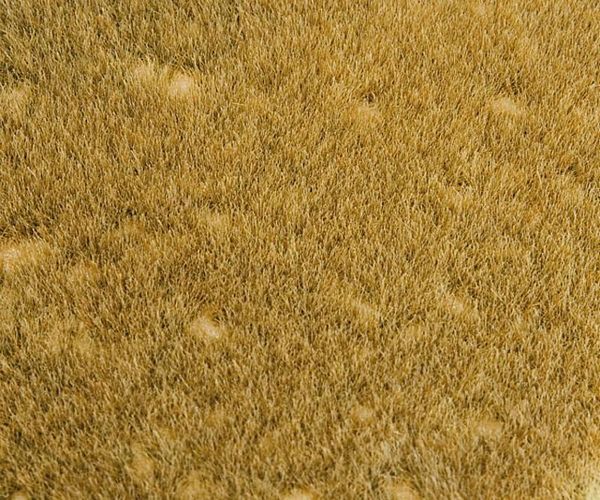
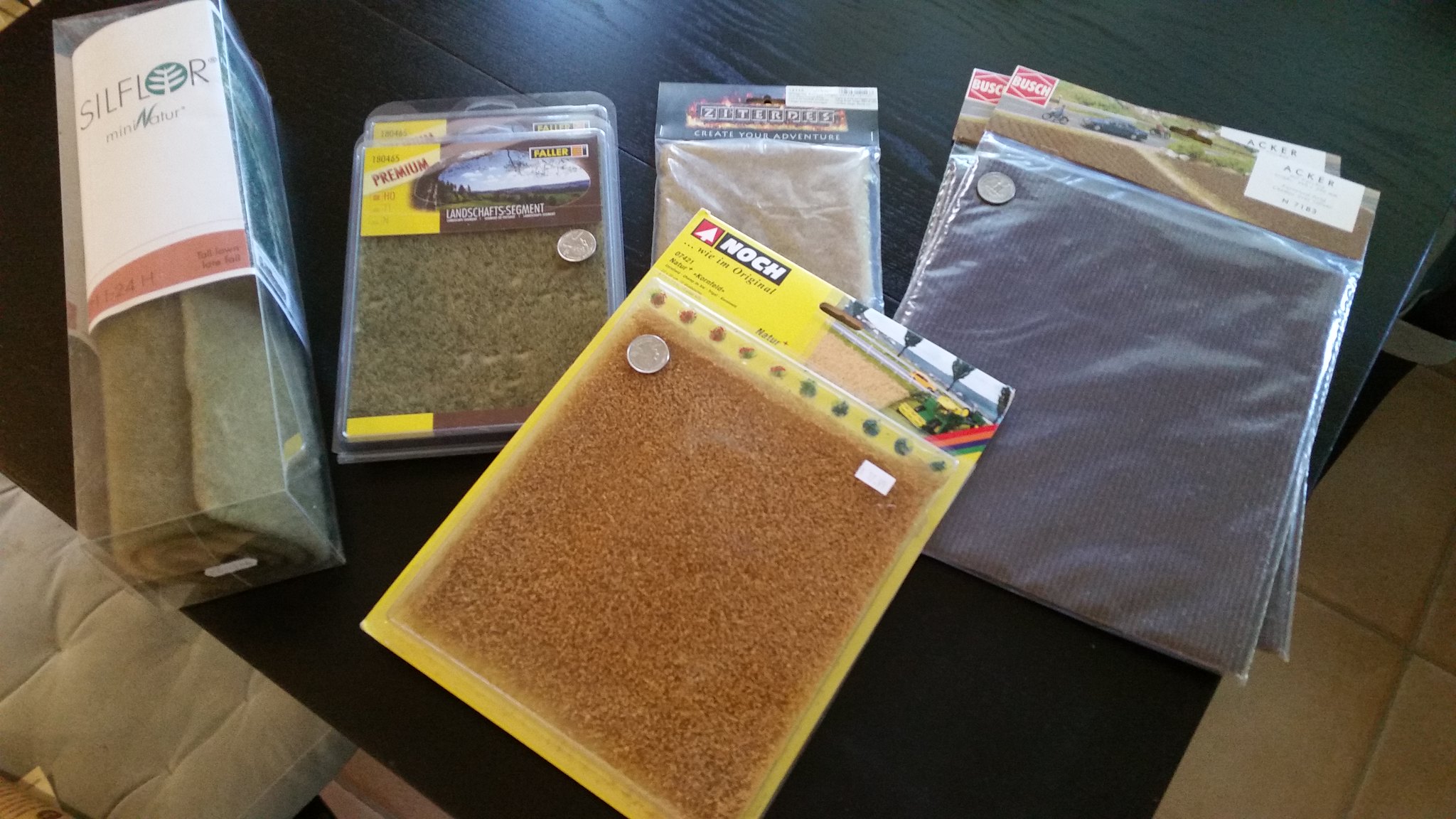

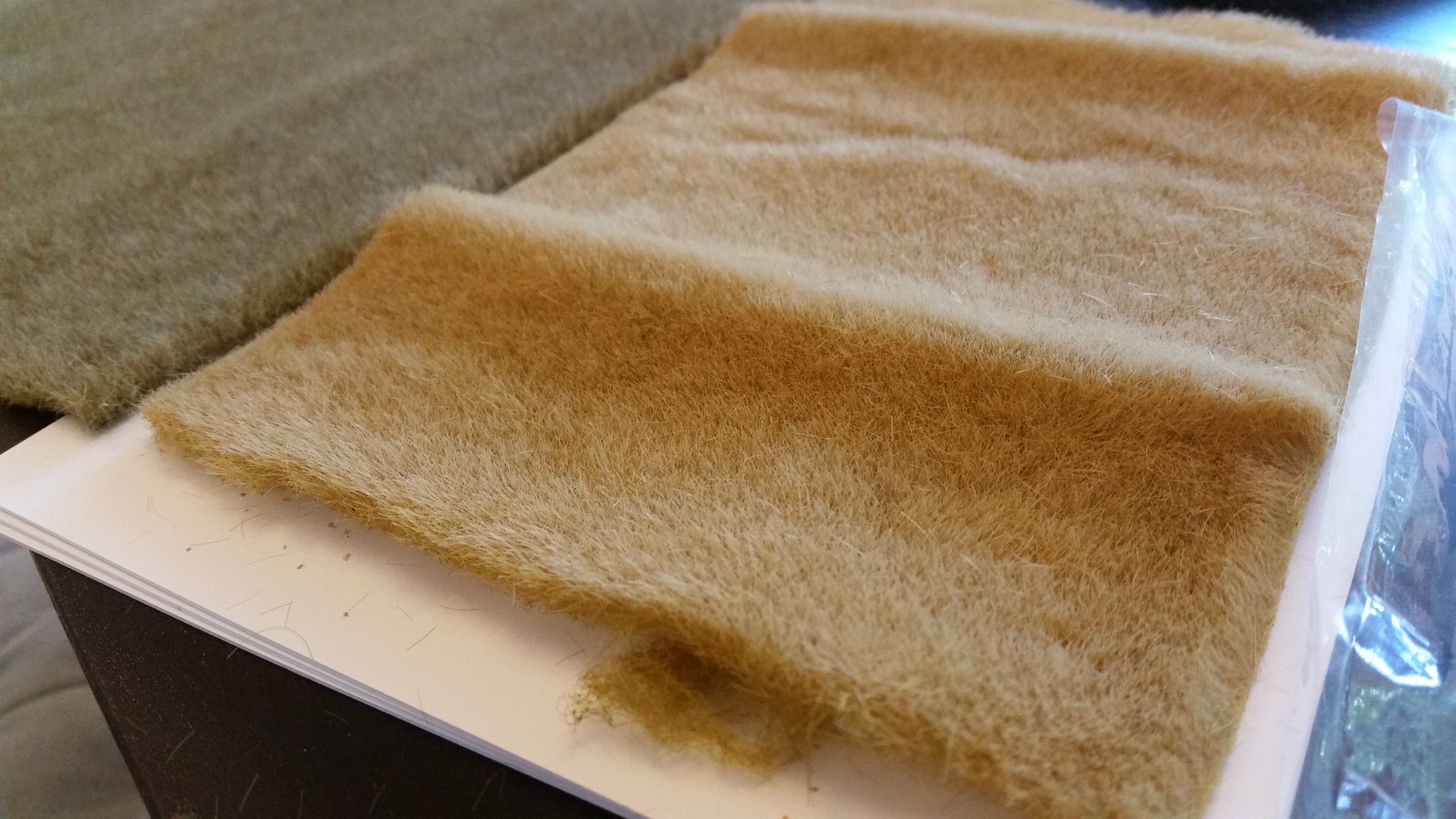
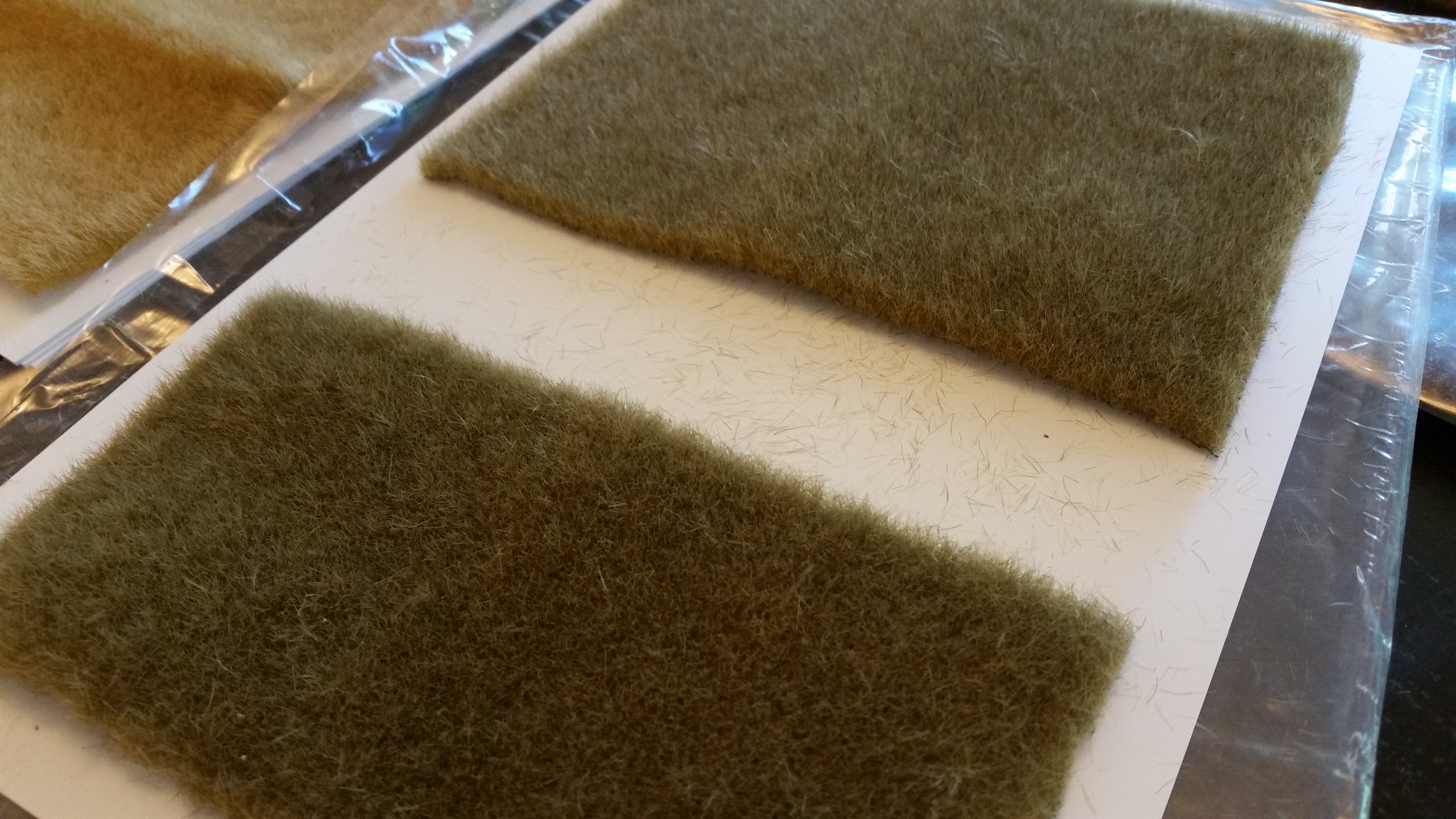
http://theminiaturespage.com/boards/msg.mv?id=380837 is a thread I started on TMP asking for some advice. I wanted to replicate things like this into my landscape:
Busch makes something like this, but I havent found it in the US yet. http://www.amazon.co.uk/gp/product/B0002OHBB0?psc=1&redirect=true&ref_=oh_aui_detailpage_o00_s00
This was recommended in the above thread, and really kicked off my hunt.
http://www.rocousa.com/faller_180465_premium_landscape_segment_wild_grass_meadow.asp
They were $14 USD each, and I added tracking since I wasn't sure about the reseller, but everything arrived and they look amazing (albeit small, 6"x8"). Expensive but nice...I'll likely base one as is, and cut the other one up for small yards, etc in 6mm.

I finally got most of the product in and took some side-by-side shots of what I had found. The group shot (I sprinkled some US quarters about for size comparisons):

The fields on the right are from Scenic Express: http://www.sceneryexpress.com/SMALL-FURROW-PLOWED-FIELD/productinfo/BH7183/
The cornfield in the middle front is http://www.sceneryexpress.com/NATURE-PLUS-WHEAT-FIELD/productinfo/NH07421/
The big box in the top left is http://www.sceneryexpress.com/SILFLOR-4MM-MEDIUM-AUTUMN-LAWN/productinfo/SF71124/

Below, you can see the Ziterdes mat. It was wrapped in on itself, so I am STILL trying to get the bends out.

The Silflor mat is on the left, below, with the Ziterdes product on the right. You can see how almost identical they are.
The Silflor sheet cut so easily with scissors. Here it is resting on some 1mm polystyrene sheeting - and you can see how much it sheds!

Of course, I didnt realize at the time, but Ziterdes is made in conjunction with Noch - and I wager I paid a bit more for the gaming application. Still, the Silflor product is as good as I could have hoped for. My only real complaint about the Silflor is the color - I would have liked it a bit more golden wheat colored, like the Ziterdes one, but alas, it'll do.
I am waiting on some 6mm stone walls to arrive from Leven Miniatures, after which I'll get some of these based up, but I am happy with what I see so far. The only California Gold fields I see like that Silflor one are in 6mm height...thats a bit tall, I think.
Subscribe to:
Posts (Atom)


